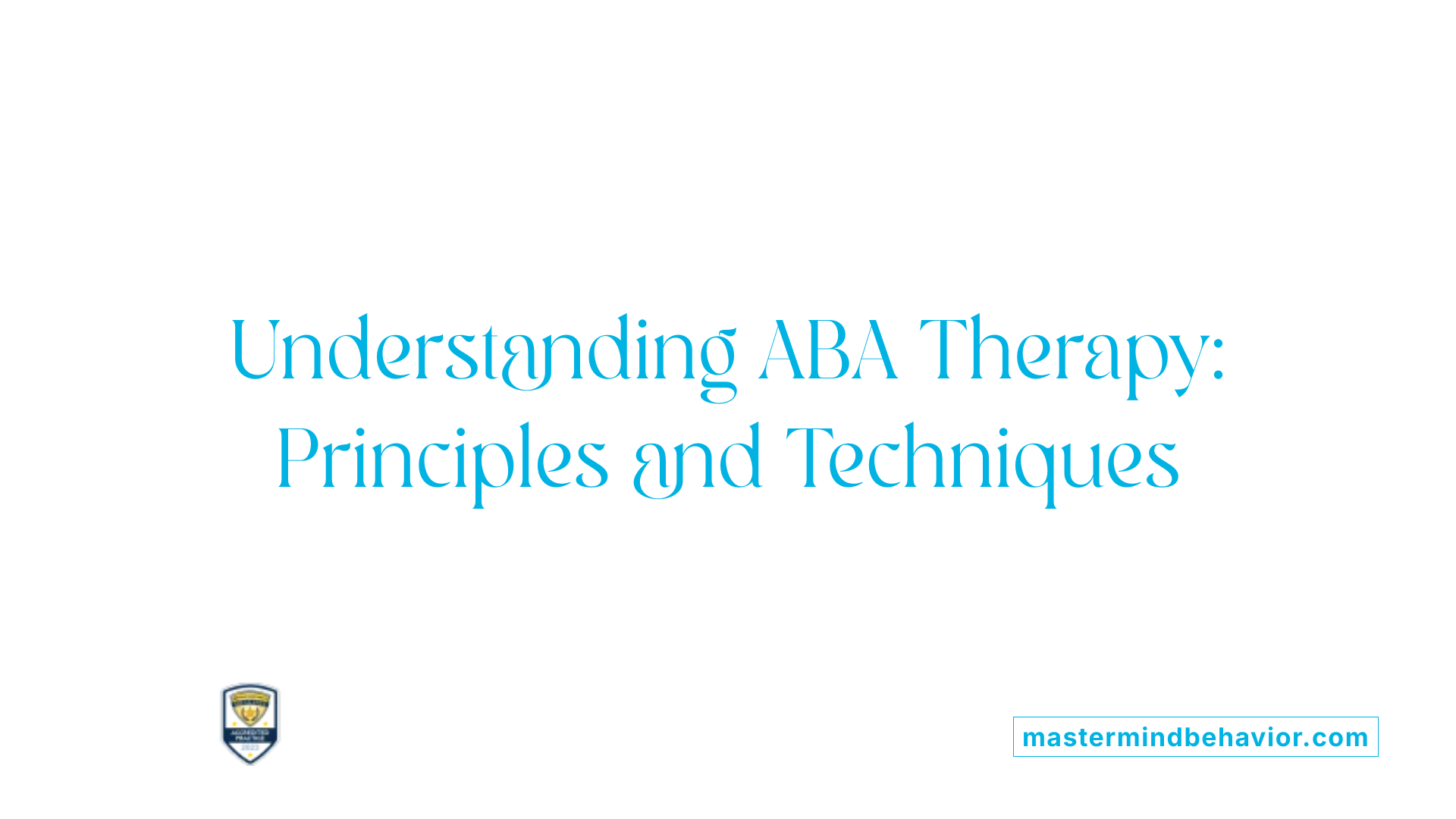How ABA Therapy Encourages Teamwork And Cooperation Skills

Understanding ABA Therapy and Its Core Principles
Applied Behavior Analysis (ABA) therapy stands at the forefront of evidence-based treatment for individuals with autism, emphasizing the development of essential skills through scientific learning principles. This therapy not only addresses individual behavioral needs but also lays the foundation for social cooperation and teamwork, crucial for success in diverse settings. This article explores how ABA therapy encourages teamwork and cooperation skills, weaving through its principles, implementation, and collaborative approaches among professionals, families, and individuals themselves.
What is Applied Behavior Analysis (ABA) Therapy?

Definition and Core Approach of ABA Therapy
Applied Behavior Analysis (ABA) therapy is a scientific and evidence-based treatment designed to understand and improve behavior. It uses principles of learning and motivation, focusing on analyzing what happens before a behavior (antecedents), the behavior itself, and the consequences that follow. By examining these factors, ABA aims to teach new skills and reduce problematic behaviors.
Use of Behavioral Analysis and Positive Reinforcement
A central technique in ABA is positive reinforcement, where desirable behaviors are encouraged and rewarded to increase their occurrence. This approach helps children learn effectively by associating positive outcomes with good behavior. ABA therapists carefully tailor interventions to each child's needs, ensuring personalized support.
Individualized Techniques and Therapy Settings
ABA therapy employs various methods such as discrete trial training, Pivotal Response Treatment, and the Early Start Denver Model. These techniques are adapted to the individual's abilities and goals. Therapy can take place in multiple environments, including homes, schools, or specialized centers, providing flexibility and consistency.
Skills Targeted by ABA Therapy Including Communication and Social Interaction
ABA focuses on enhancing a broad spectrum of skills. It helps develop communication abilities by teaching verbal imitation, picture exchange systems, and natural requesting. Additionally, social skills like making eye contact, taking turns, understanding emotions, and building friendships are cultivated through methods like natural environment training.
Scientific Basis and Recognition as Gold Standard Treatment
Supported by extensive research and professional organizations, ABA is recognized as the gold standard for autism treatment. It has proven effectiveness in improving intellectual functioning, language, adaptive behaviors, and reducing challenging behaviors such as tantrums and aggression. These benefits often continue long after therapy concludes, underscoring ABA's lasting impact.
How ABA Therapy Supports the Development of Teamwork and Cooperation Skills

Focus on social skills development such as eye contact, turn-taking, and friendship building
ABA therapy targets foundational social skills essential for teamwork and cooperation. By teaching children with autism to make eye contact, take turns during interactions, and understand how friendships develop, therapy fosters meaningful social engagement. These skills create a groundwork for cooperative play and group activities.
Use of natural environment training to enhance real-life social interactions
Natural environment training is an ABA technique that uses everyday settings like home or school to practice social behaviors. This approach helps children apply learned skills in real-life situations, improving their ability to cooperate with peers during spontaneous interactions.
Strategies for emotional regulation and understanding emotions
ABA therapy incorporates methods to help children recognize and label their emotions. Through calming techniques and emotional regulation strategies, children learn to manage feelings that impact social cooperation, promoting smoother teamwork and conflict resolution.
Teaching communication skills that enable cooperative interactions
Effective communication is key to working well with others. ABA teaches various communication methods, including verbal imitation and picture exchange systems, enabling children to express needs, share ideas, and participate actively in group tasks.
Role of positive reinforcement in encouraging prosocial behaviors
Positive reinforcement strengthens prosocial behaviors by rewarding desired actions such as sharing, helping, and cooperating. This encouragement motivates children to repeat these actions, reinforcing teamwork skills over time.
How does ABA therapy help individuals with autism?
ABA therapy systematically builds skills in communication, social interaction, independence, and everyday living by using structured, individualized techniques. It emphasizes positive reinforcement and understanding behavior triggers. By involving caregivers and educators, it ensures skill generalization across settings. Supported by scientific research, ABA promotes improved language, social abilities, and functional independence, particularly when begun early and practiced intensively.
| Aspect | Description | ABA Therapy Application |
|---|---|---|
| Social Skills | Eye contact, turn-taking, friendship building | Taught through structured and natural environment activities |
| Emotional Regulation | Recognizing and managing emotions | Calming techniques and emotion identification |
| Communication | Verbal/non-verbal communication, picture exchange | Communication systems and imitation exercises |
| Positive Reinforcement | Rewarding prosocial behavior to increase frequency | Use of praise, tokens, or preferred items to encourage behaviors |
| Real-life Practice | Generalizing skills across home, school, and community | Natural environment training to enhance real-world application |
The Multidisciplinary Team Behind ABA Therapy

Roles of Board Certified Behavior Analysts (BCBAs) and Registered Behavior Technicians (RBTs)
ABA therapy is delivered by a well-trained team. At the forefront are BCBAs, who design individualized treatment plans and oversee their implementation. They analyze data and make adjustments to ensure effective progress. RBTs support daily therapy activities by working directly with the child, implementing behavior plans under BCBA supervision. Together, they form the foundation of ABA services, ensuring interventions are personalized and evidence-based.
Collaboration with Occupational and Speech Therapists
To address the multiple needs of children with autism, ABA therapists frequently collaborate with occupational and speech therapists. Occupational therapists focus on building daily living skills and sensory integration, while speech therapists work on communication development. This teamwork allows for a comprehensive treatment approach, targeting behavior, sensory needs, communication, and independence simultaneously.
Importance of Therapists, Behavior Analysts, and Parents Working Closely Together
Parents are vital partners in the therapy process. Regular meetings and planning sessions involving therapists, behavior analysts, and parents create a unified team. This collaboration helps maintain consistency across environments such as home, school, and community. It also empowers parents to apply techniques like visual schedules, sensory strategies, and positive reinforcement, which reinforce therapy gains.
Team Communication Such as Progress Note Sharing and Data Collaboration
Consistent communication among team members is key. Sharing progress notes and behavioral data supports coordinated intervention strategies and timely adjustments. This open exchange ensures all professionals are informed about the child's current status and can align their goals and methods effectively.
Coordination Strategies to Optimize Therapy Outcomes
Teams use structured coordination methods to maximize therapy success. These include synchronized scheduling, joint training sessions, and multidisciplinary meetings. By blending expertise and staying connected, the team creates a seamless support system that fosters skill generalization across various life settings.
Through this collaborative, multidisciplinary model, ABA therapy provides children with autism a comprehensive, well-rounded approach to developing essential skills and reducing challenging behaviors.
Practical Techniques in ABA That Foster Cooperation

Use of routines, visual schedules, and sensory integration techniques
ABA therapy often employs structured routines and visual schedules to provide predictability and clarity for children with autism. These tools help reduce anxiety and promote cooperation by outlining what to expect throughout the day. Sensory integration techniques, supported by occupational therapy, assist children in adapting to varying sensory inputs, which can otherwise disrupt focus and willingness to participate.
Implementation of positive reinforcement at home and school to generalize skills
Positive reinforcement is a cornerstone of ABA therapy. By rewarding desired behaviors consistently, both at home and in school settings, children are motivated to repeat cooperative behaviors. Families and educators are encouraged to use the same reinforcement strategies to promote skill generalization across all environments, enhancing the child’s ability to work well with others.
Personalized strategies to reduce challenging behaviors that interfere with cooperation
ABA therapy involves identifying triggers for challenging behaviors, such as tantrums or aggression, and developing personalized interventions to address these. Strategies include teaching alternative communication methods and reinforcing positive interactions. This individualized approach helps children engage more cooperatively in social and academic tasks.
Integration of occupational therapy to promote independence and adaptability
Occupational therapy complements ABA by focusing on functional daily living skills and sensory integration, which are fundamental for cooperation. Improving a child’s ability to manage personal hygiene, household tasks, and sensory sensitivities fosters independence and reduces frustrations that can hinder teamwork.
Breaking down academic and cognitive tasks to encourage teamwork
ABA techniques break down complex academic activities into manageable steps using visual supports and reinforcement. This step-by-step approach not only boosts a child’s confidence but also creates opportunities to practice cooperative skills like turn-taking and sharing responsibilities, encouraging positive peer interactions.
| Technique | Purpose | How It Supports Cooperation |
|---|---|---|
| Routines and Visual Schedules | Provide structure and predictability | Reduce anxiety; make transitions smoother |
| Sensory Integration | Help adapt to sensory input | Improve focus; decrease disruptive behaviors |
| Positive Reinforcement | Motivate repetition of desired behaviors | Encourage participation and social engagement |
| Personalized Behavior Strategies | Decrease challenging behaviors | Increase cooperative behaviors in various settings |
| Occupational Therapy Integration | Build independence and sensory regulation | Enhance adaptability for teamwork situations |
| Task Breakdown in Academics | Simplify learning and increase task success | Foster peer cooperation and shared task completion |
The Role of Family and Caregivers in Promoting Teamwork Skills

Why Is Family Involvement Essential in Therapy?
Family involvement forms the foundation of effective ABA and occupational therapy outcomes. Regular communication between families and therapists ensures ongoing progress updates and helps tailor interventions that fit the child's evolving needs. This partnership fosters consistency, which is crucial for skill generalization beyond therapy settings.
How Does Parent Training Reinforce Therapy Gains?
Through parent training programs, caregivers learn techniques used in therapy, such as positive reinforcement, visual schedules, and sensory strategies. These skills enable parents to reinforce and practice targeted behaviors and routines at home, helping children transfer and maintain new skills effectively.
Extending Benefits Through Home and Community Routines
Implementing structured routines, sensory integration methods, and communication supports like picture exchange systems at home and in the community broadens the child’s ability to apply learned behaviors across environments. Such consistency accelerates development and improves independence in daily living skills.
Collaborative Goal Setting for Personalized Support
Families actively participate in setting goals together with therapists and behavior analysts. This collaboration ensures intervention plans address specific family priorities and cultural contexts, leading to more meaningful and achievable outcomes for the child.
Building Support Networks to Sustain Progress
Support from extended family, caregiver groups, and community services strengthens the cooperative dynamic vital for teamwork skills development. Networks provide ongoing encouragement and resources, helping families maintain the momentum of therapy and adapt strategies as the child grows.
By engaging deeply in these ways, families and caregivers serve as vital partners in the therapy process, ensuring that the benefits of ABA and occupational therapy extend well beyond the clinical environment and into everyday life.
Core Principles of ABA That Underpin Teamwork and Collaboration
What are the key principles behind ABA therapy?
Applied Behavior Analysis (ABA) is rooted in several fundamental principles that guide effective treatment. At the heart of ABA is reinforcement, both positive and negative, which encourages desirable behaviors and discourages negative ones. Understanding the functions of behavior—such as seeking attention, escaping a situation, or gaining access to preferred items—is essential for developing personalized strategies.
ABA utilizes systematic procedures including prompting (providing cues), shaping (rewarding gradual approximations towards a behavior), and fading (gradually removing prompts) to teach and refine skills. Functional Behavior Analysis (FBA) helps identify behavioral triggers, particularly those affecting social participation, enabling teams to tailor interventions.
An emphasis on generality ensures that learned skills transfer across different environments—home, school, community—and with various people. This broad application requires consistent teamwork between therapists, behavioral analysts, parents, and educators.
Data-driven methods allow for individualized treatment plans continually adapted based on collected data and progress. This approach ensures each child receives focused support targeting their unique strengths and challenges.
Teamwork and collaboration are therefore foundational within ABA, enabling multiple professionals to share information, strategize, and maintain consistent reinforcement across all settings. By combining behavioral principles with collaborative processes, ABA therapy effectively enhances social, communication, and daily living skills in children with autism.
Cultural Competence and Communication Within ABA Teams
Why Is Cultural Competence Important in ABA Therapy?
Cultural competence ensures ABA therapists provide effective, respectful treatment tailored to the diverse backgrounds of children and families. Understanding cultural values, communication styles, and unique family dynamics helps therapists design interventions that resonate and avoid misunderstandings.
How Does Respectful Communication Enhance Teamwork?
Respectful and empathetic communication fosters collaboration among therapists, families, and other professionals. When all parties feel heard and valued, it promotes trust, smooths therapy implementation, and supports a unified approach to the child's development.
How Are ABA Therapists Trained in Cultural Awareness?
Training includes formal education, internal training sessions, and practical experience focused on recognizing cultural differences and adapting intervention strategies accordingly. Therapists develop skills such as active listening, open-mindedness, and culturally sensitive data collection.
What Is the Impact of Diversity on Therapy Planning and Execution?
Diversity influences goal setting, intervention methods, and communication channels. Therapists adjust techniques to align with family traditions and community norms, ensuring goals are meaningful and achievable while respecting cultural perspectives.
How Are Family and Community Values Included in Interventions?
Therapists collaborate closely with families, incorporating their values and preferences into routines, visual schedules, and reinforcement strategies. This inclusion boosts engagement, promotes skill generalization, and enhances the child’s quality of life across environments.
| Topic | Key Points | Practical Example |
|---|---|---|
| Importance of Cultural Competence | Tailoring treatment, avoiding misunderstandings | Adjusting communication style to family's primary language |
| Respectful Communication | Builds trust and cooperation | Collaborative meetings including parents and multiple therapists |
| Training in Cultural Awareness | Focus on cultural sensitivity, practical adaptation skills | Role-playing cultural scenarios during staff training |
| Impact of Diversity | Shapes goal setting and intervention strategies | Modifying routines to fit cultural meal or hygiene practices |
| Inclusion of Family and Community Values | Ensures relevance and acceptance of therapy | Developing visual schedules reflecting family daily activities |
Long-Term Benefits of Teamwork-Focused ABA Therapy
Sustained Improvements in Social, Intellectual, and Adaptive Functioning
Early intensive ABA services have been shown to lead to significant long-term gains for children with autism. These improvements often extend beyond the treatment period, positively impacting intellectual functioning, language development, and adaptive behaviors. The structured, evidence-based interventions provided by ABA facilitate ongoing growth in communication skills, social interactions, and daily living activities.
Maintenance of Skills Beyond Therapy Through Consistent Support
A critical factor in maintaining these skills over time is the collaborative support from therapists, educators, and families. Regular communication and progress updates enable caregivers to implement strategies such as visual schedules, positive reinforcement, and sensory integration techniques consistently at home and school. This coordination ensures that skills generalize across various environments, preventing regression and reinforcing behavioral improvements.
Increased Independence and Community Participation
ABA therapy's focus on enhancing independence is vital for increasing a child's participation in community and school activities. By targeting self-care routines, household tasks, and emotional regulation strategies, children gradually gain the confidence and ability to navigate daily life more independently. This growth contributes to better social integration and quality of life.
Positive Outcomes Linked to Early Intensive Treatment
The benefits of ABA therapy are most profound when interventions begin early and are intensive. Early treatment allows for foundational skills to be established during crucial developmental windows, supporting greater intellectual, social, and adaptive outcomes later in life. This front-loaded approach optimizes the child's developmental trajectory and long-term success.
Quality of Life Enhancements Through Collaborative Care Approaches
Teamwork among clinicians, therapists, families, and community stakeholders forms the backbone of effective ABA therapy. When professionals across disciplines coordinate their efforts, share data, and involve families actively, children receive comprehensive care that addresses all facets of their development. This synergy not only improves therapy outcomes but also enriches the child's overall quality of life, fostering continued growth well into the future.
Teamwork and Cooperation: Building Foundations for Lifelong Success
ABA therapy’s strength lies not only in its scientific rigor but also in its collaborative framework that fosters teamwork and cooperation among children with autism, their families, and multidisciplinary professionals. Through individualized, evidence-based interventions and positive reinforcement strategies, ABA empowers individuals to engage more effectively with others, navigate social environments, and build meaningful relationships. The active involvement of caregivers and skilled teams ensures that these essential social skills generalize across various settings, supporting autonomy and enhanced quality of life. As ABA therapy continues to evolve with an emphasis on cultural competence and interdisciplinary cooperation, it remains a vital pathway for fostering the teamwork and cooperation skills foundational to personal growth and societal integration.
References
- The Benefits of Combining ABA and Occupational Therapy
- Top 7 Benefits Of ABA Therapy For Autistic Children
- What does effective collaboration look like in an ABA ...
- What Skills Benefit ABA Therapists: Success in Autism ...
- Applied Behavior Analysis (ABA)
- The Top 10 Reasons Children With Autism Deserve ABA
- 6 Benefits of ABA Therapy for Children with Autism
- Applied Behavior Analysis (ABA)
- The Controversy Around ABA
Recent articles

How ABA Therapy Encourages Teamwork And Cooperation Skills
Unlocking Social Success: The Role of ABA Therapy in Fostering Teamwork and Cooperation

Teaching Coping Skills For Test Anxiety Through ABA Therapy
Harnessing ABA Therapy to Equip Children with Autism Against Test Anxiety

ABA Therapy For Supporting Flexibility In Changing Schedules
Navigating Change: ABA Therapy as a Lifeline for Flexible Routines

How ABA Therapy Improves Coping During Times Of Transition
Navigating Change with Confidence: The Role of ABA Therapy

How ABA Therapy Improves Morning And Bedtime Routines
Transforming Daily Habits: The Role of ABA Therapy in Structured Routines for Autism

How ABA Therapy Improves Coping With Unstructured Free Time
Enhancing Daily Living: ABA Therapy and Managing Unstructured Time for Children with Autism



